Introduction
It is a well-known fact that nowadays the defense agencies all over the world invest a lot of money in improving the security level of their countries. For instance, millions of dollars are put into the development of various robots. Today the robots have different technical characteristics and therefore can be used with different purposes. Some of them contain video cameras and are used in observations, others are armed and can be used directly in the battle field.
It is hard, however, to catch up with all the modifications and improvements in the sphere of robot design and construction. For instance, only a month ago a world known Polish robot producing company Przemyslowy Instytut Automatyki i Pomiarow (PIAP) introduced their version of a tactical throwable robot (TRM). The main purpose of this device is teleobservation, which is often used by military services, and “counter-terrorist operation support” (Berg, 1). However, this institution was not the first who invented the general model of this robot. Tactical throwable robots are being developed by a multitude of companies for several decades already, but lately the popularity of this kind of robot increased significantly.
Technical characteristics
During the years of the machine’s development, there has been set a standard construction for the tactical throwable robots. Specifically, due to its main functions, such as reconnaissance, the tactical throwable robot as a rule contains a videocamera and a microphone mounted inside it. One of the most important features of the robot is its small size and high portability, which can be controlled on distance. The main technical characteristics of the machine are given below in the table offered by Czupryniak Rafal and Trojnazki Maziej in their article “Throwable tactical robot – description of construction and performed tests” (Czupryniak, 29).
The new tactical throwing robot offered by the PIAP has similar characteristics. To be specific, its weight is 1,3 kg, and its maximum speed is 3, 3 km/hr. As we can see, most parameters are at their maximal possible level, such as range inside the building and range in open space, which are, correspondingly, 120 and 150 m (Williams, 1).
Construction
A tactical throwing robot presented by the company looks like this (Czupryniak, 29):
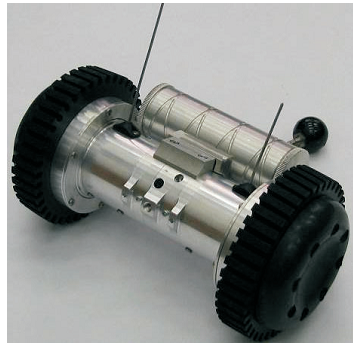
In order to understand its construction better, it will be rational to analyze it from inside. The first throwable robot, developed by the TMR, looked like the following picture (Barnes, 4):
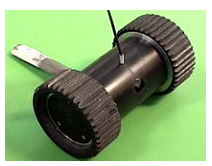
Of course its moving capability was rather limited (Barnes, 5). The modern version of the robot body offered by PIAP has an improved construction. It has a cylindrical form and all the other details are mounted into it (Czupryniak, 29).
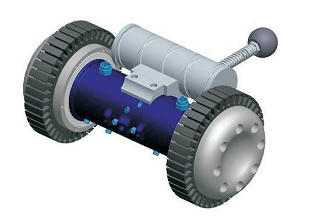
The cylinder inside has not a smooth but a ribbed surface, which prevents the machine from deformation and serves as a basis for other details. For instance, the electronic plates are fixed inside the body (Czupryniak, 29):
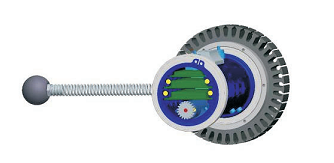
In addition, the battery is mounted on the other side of the cylinder (Czupryniak, 29):
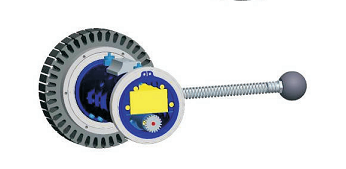
The engine of the TTR is situated outside the cylinder. In addition, the bearings connect the wheel rims with the robot body.
Interestingly, the mechanism of turning the robot on is unlike the conventional ones. Once the wheel is turned, the machine automatically starts to move. In order to turn it off, however, one needs to use the remote control.
As one of the earlier developers of the throwable robots noted, it “can function in loose soil with small obstacles but is most effective on relatively flat surfaces like streets and sidewalks, making it ideal for an urban, desert environment” (Moreau, 1). However, another specialist in the field states that the tactical throwable robots have to be able to show their best in such conditions as “mud bogs, water obstacles, steep culverts, rock beds, and a series of movable ramps covered with sand, gravel, and loose pipes” (Behar, 1). Sure enough, the PIAP robot can withstand all of the named conditions.
Electrical part
As for the electronic construction of the robot, Czupryniak states that such sectors can be named: “supply module, micro controller with peripheries managing the model’s functions, engine drive programmer, vision transmitter, telemetry receiver, interface scheduling CAN BUS” (Czupryniak, 29).
Control panel
Another important constituent of the tactical throwable robot is the control panel. Its general look is illustrated by the photo below (Czupryniak, 30).
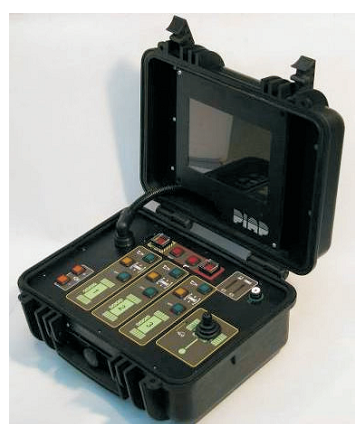
This panel weights up to 7 kg. The properties of the material used for producing the control panel are rather impressive; they include resistance to water, high and low temperatures, chemical reactions, etc. Besides the monitor and loudspeakers in the upper part of the box, there is also a small antenna that improves the quality of the signal. What is more, the innovations offered by PIAP include using the TFT matrix rather than the LCD one for the monitor. This solution allows both obtaining a picture of better quality and preserving the energy use. Needless to say, all the data received from the tactical throwable robot can be recorded with the help of the control panel.
On the lower part of the box, we can see a control column and a number of buttons, each of which is used to stimulate a certain function performance in the robot. What is more, the control panel box contains an exchangeable battery, or, to be more specific, with an “eight-cell lithium-polymer battery package” (Czupryniak, 30). The properties of this kind of battery perfectly fit the needs of the device with all its peculiarities, such as portability and extreme conditions of work.
As we could see in the table given earlier, the maximal number of controlled devices is 3. This number means that with the help of one control panel the operator will be able to work with three tactical throwable robots at a time. In addition, not only the connection between each robot and the panel is set; the robots can also contact with each other.
Comparison with other throwable robot
In order to have something to compare the PIAP model with, it is enough to look at a throwable robot offered earlier by Recon Scout. Its general characteristics and outlook are the following (Klobucar, 2):

Conclusion
Taking into consideration all the mentioned technical characteristics of the PIAP robot, it can be stated that the model can become a significant improvement in the defense services of different nations. It can save a lot of time, and, which is most important, protect the lives of real soldiers.
Works Cited
Barnes, Mitch, Everett, H. ThrowBot: Design Considerations for a Man-portable Throwable Robot. San Diego: IRobot, Inc, 2004.
Behar, Michael. The New Mobile Infantry. Wired, 2009. Web.
Berg, John. Intelligent robots have shown what they can do. MSPO, 2010. Web.
Czupryniak, Rafal, Trojnazki, Maziej. Throwable tactical robot – description of construction and performed tests. Journal of Automation, Mobile Robotics & Intelligent Systems, 4(4), 2010: pp. 26-32.
Klobucar, Jack. Mission-critical Reconnaissance from a Miniature, Mobile Throwable Robot. Toronto: Recon Robotics, Inc, 2009.
Moreau, Dave. Remote-Controlled Throwable Robot Sent To Iraq For Testing. Space Daily, 2004. Web.
Williams, Herbert. PIAP displays latest UGV developments. Jane’s International Defence Review, 43, 2010: p14-14.